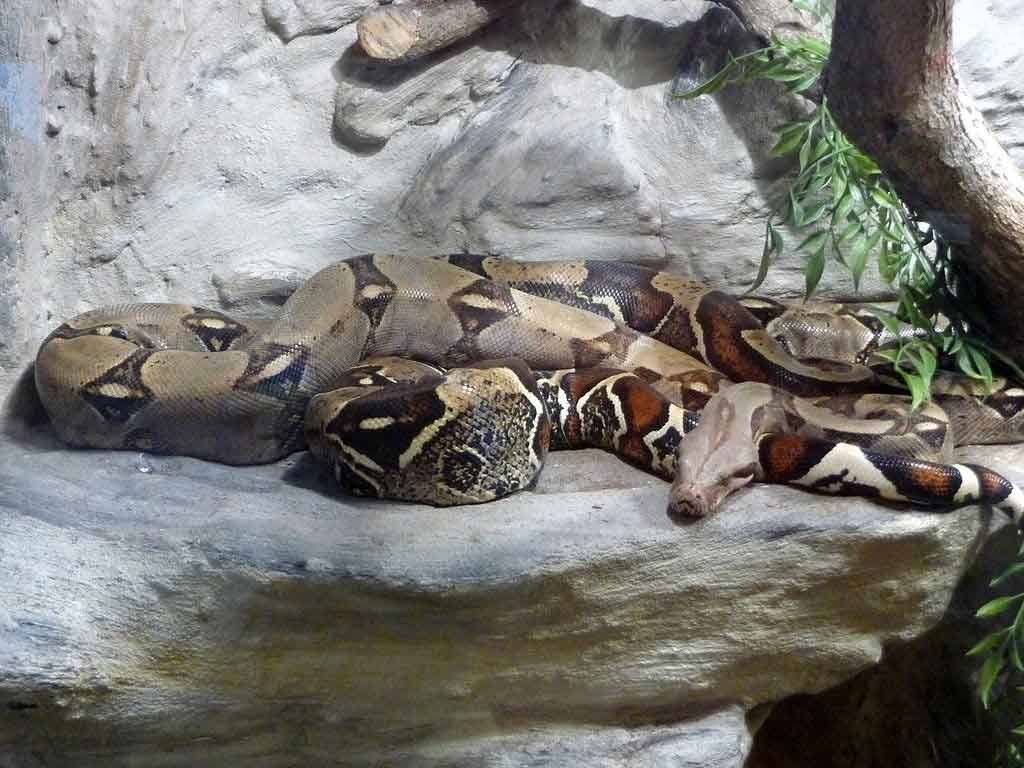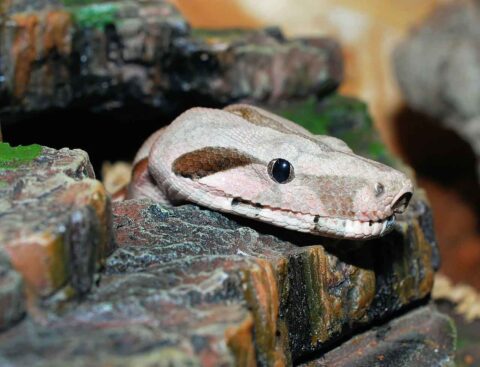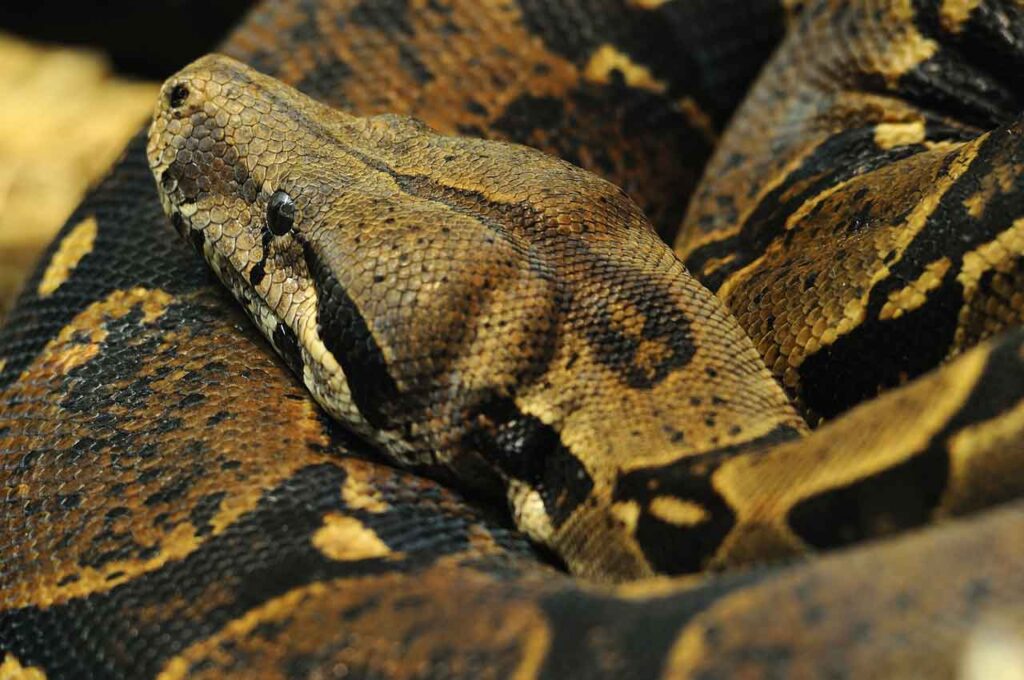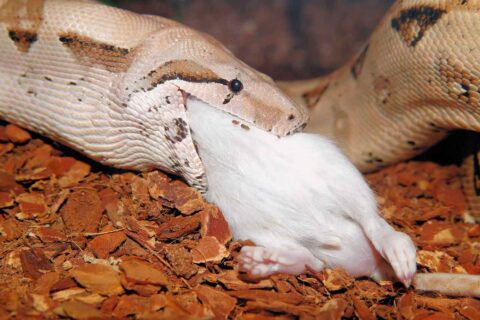
Content |
|---|
Description
The Boa constrictor bears some of the most distinctive markings of all reptiles. Depending on the habitat in which they try to camouflage themselves, their bodies may be tan in color, green, red or yellow, and display cryptic patterns of jagged lines, Ovals, rhombuses and circles.
Much smaller than anacondas, boas can measure up to 4 meters and weigh more than 45 kg. Their jaws are lined with small hook-shaped teeth to grab and hold prey as they wrap their muscular body around the victim., squeezing it until it suffocates. Boas eat almost everything they can catch, including birds, monkeys and wild pigs. Their jaws can stretch very far to swallow large prey whole.
Habitat

The Boa constrictor (Boa constrictor) is a giant snake that is distributed in several subspecies from South America to Central America.
Just like their premiums, the Anacondas, they are excellent swimmers, but prefer to stay on dry land, living mainly in hollow logs and abandoned mammal burrows.
Several subspecies are bred in captivity, local forms, as well as crosses and color variants, most often the two subspecies:
- Red-tailed Boa (Boa constrictor constrictor)
- Boa imperator (Boa constrictor imperator)
Specimens caught in the wild in the trade can also be found. If possible, specimens bred in captivity should be used.
In many countries, snakes Boas are subject to species protection legislation. The two subspecies mentioned are not subject to registration; However, proof of origin is mandatory for the holder.
In some countries, the possession of the Boa constrictor is regulated by the regulations on the possession of so-called “potentially dangerous animals”.
Sex differences
Sex determination based on external characteristics is difficult. Males have longer spurs; females are usually larger and heavier. Other methods of sex determination, as the “popping” y el sondeo, should only be performed by a veterinarian who is familiar with reptiles, due to the risk of injury.
The Boa constrictor in captivity

Behavior
The Boa constrictor is a solitary animal, but it can usually be socialized without problems if the animals are expected to be about the same size..
The Boa constrictor it is viviparous. The eggs are not laid by the female - as is often the case with snakes., Rather, they remain in the uterus until the young hatch.. Litter size can be up to 60 pups in large females. So, if breeding is not planned or desired, animals should only be kept individually or in groups of the same sex.
As there is currently an oversupply of Boa imperator and there are hardly any buyers for the young, animals should only mate if there are reliable buyers for the offspring.
The Boa constrictor is twilight and nocturnal, but it also has diurnal phases.
Accommodation (Terrarium)
To keep one or two adult animals, the terrarium must be at least the size 250 x 100 x 200 cm.. For animals with a body size greater than 2 m, even larger base areas needed. Permanent maintenance is not allowed on so-called racking systems.
Terrarium temperature
Like warm-blooded animals, the Boa constrictor you need a temperature gradient in the terrarium that allows you to reach your optimal body temperature. As such, a heating system is installed on the floor outside the terrarium, on one side, to ensure localized heating of up to 35 °C. It is also possible to use radiant heaters with UV components. The soil temperature in the rest of the terrarium should be about 26 – 28 °C; at night the temperature should drop to a few 22 °C.
Terrarium humidity
Humidity should hover between the 60 and the 80 % and can increase up to more than 90 % At night. This can be achieved by spraying the terrarium daily with warm water or using an irrigation system.. Precise thermometers and hygrometers are needed to measure temperature and humidity.
Terrarium lighting
Fluorescent tubes are suitable as basic lighting; the duration of illumination should be 10 to 12 hours. Lighting should be placed out of reach of snakes or secured with a metal mesh basket (Fire danger!).
Terrarium furniture
The shelves, stable rock structures (also imitations), the thickest roots and/or branches, as well as cork tubes and other cave-like hiding places have proven to be suitable. There must be at least one retreat for each animal. The Boa constrictor climb well; Therefore, the furniture must be well installed in the terrarium so that the animals can not harm themselves. The presence of a sufficient number of rough surfaces makes it easier for animals to moult regularly.. It also, a sufficiently large and temperature-controlled water battery, in which animals can also bathe, is part of the basic equipment. An absorbent substrate (for example, bark mulch) is suitable as a substrate, which should always be slightly moist at one point.
Important: There should always be a slightly moist hiding place.
Food

The Boa constrictor feeds mainly on mammals, reptiles and birds in the wild. Usually, can be fed with rodents or frozen rabbits of suitable size, that thaw quickly (for example, in warm water) and are brought to an approximate body temperature (35 – 40 °C) before feeding them. If required, frozen foods can be vitaminized with suitable preparations. Feeding live animals for food should be avoided due to animal welfare aspects and the risk of animal bite injuries for food. Fresh water must be available at all times.
If several animals are kept in the terrarium, they must be placed individually in boxes to be fed or monitored during feeding. after feeding, the animals need several days of rest and should not be disturbed.
Note: In the case of the pups, weekly feeding is adequate; in the case of older specimens, the feeding interval can be extended to 3 or 4 weeks.
Care
Food scraps, molts and droppings should be removed daily. In the case of young animals, water bowls should be cleaned daily. Larger water bowls should be cleaned and filled with fresh water at least once a week or when dirty.
Animal health should be checked daily. The most frequent health problems in the Boa constrictor are the difficulties of molting, skin mites, eating disorders, movement disorders, as well as inflammation of the respiratory tract, skin fungus, feces and mucosal alterations. In case of anomalies, you have to consult a reptile veterinarian. It is recommended to perform fecal examinations once a year to detect endoparasites.
Boas are very susceptible to inclusion body disease, a viral disease that ends up being fatal. As there is still no treatment for this disease, newly acquired animals must be quarantined for at least six months and examined by a veterinarian before they come into contact with the existing population.
The intestinal flora of the Boa constrictor usually includes salmonella, that are harmless to animals, but they can cause disease in humans. Hygiene measures (wash your hands well, etc.) can prevent infection.
Acclimatization and handling
Reptiles are observation animals and NOT companion animals. For this reason, in the first days in their new home, animals need adequate rest to get used to their new environment.
Animals should only be caught if necessary. Boas are usually peaceful, but they can bite sensitively; in the case of aggressive specimens, it is recommended to handle them with the help of gloves and / or a hook for snakes.
Attention: During the molt, animals should not be fed or taken out of the terrarium.
Special features
Colored breeds with reduced pigmentation (for example, albinos) may show increased sensitivity to light.
Buy one Boa constrictor
The price of a Boa constrictor in the exotic animal market ranges from 120 – 150 EUR.
Video Boa constrictor
Alternative names:
1. Red-tailed boa, Common boa (English).
2. Boa devin, Aviosa (French).
3. Königsschlange, Königsboa, Abgottboa (German).
4. Jiboia (Portuguese).
5. Tragavenado, Guio, Mantona, Mazacuata, Tragavenado, Jiboia, Lampalagua, Matacaballo, Limacoa, Ilama (español).
